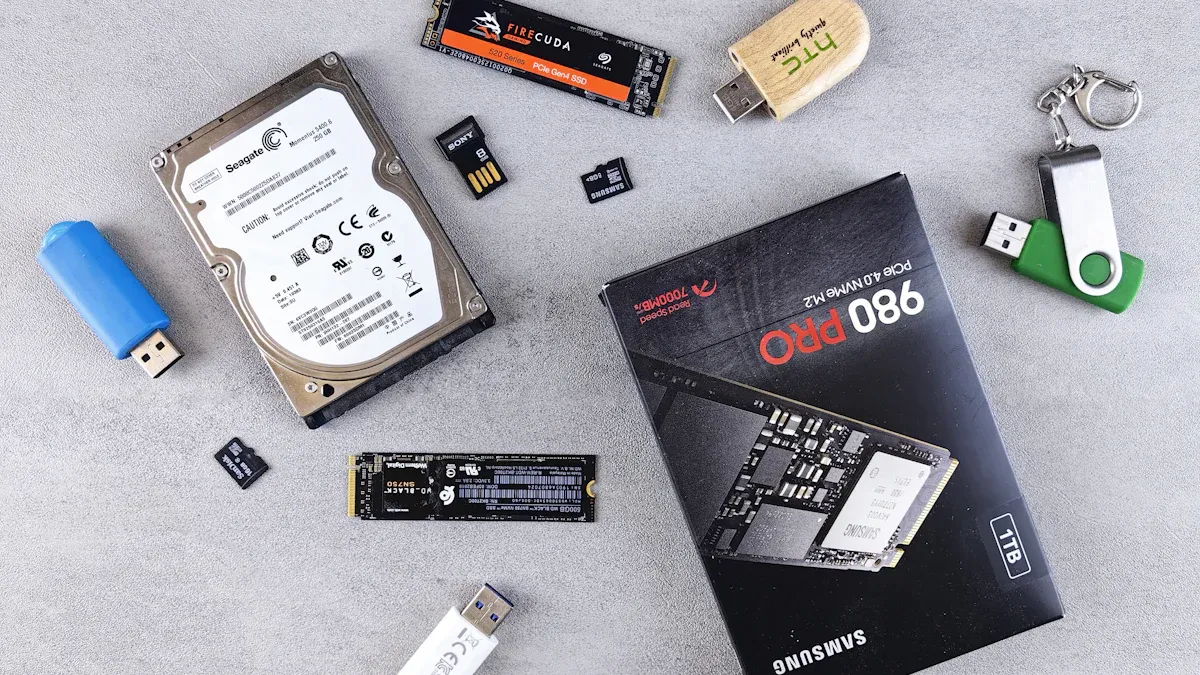Choosing Between S25FL128S and S25FL256S Flash Memory for Embedded Systems

Choosing the right flash memory is very important for devices. The S25FL128S and S25FL256S are different in size, speed, and use. The S25FL128S has 128 Mbit of storage space. The S25FL256S has 256 Mbit, which is better for bigger projects. The S25FL256S is also faster because it uses advanced SPI modes. These differences show why picking the right memory for your project is key. It helps your device work well and efficiently.
Key Takeaways
Pick the S25FL128S for medium projects needing 128 Mbit storage. It works well for saving firmware and is dependable.
Choose the S25FL256S if you need more storage and speed. It has 256 Mbit space and faster SPI modes for bigger systems.
Think about power use when picking flash memory. Both are energy-saving, which is important for battery-powered gadgets.
Match your budget with the features you want. The S25FL256S costs more but works better and lasts longer for tough tasks.
Always check if your hardware and software work with the flash memory. A good setup makes everything run smoothly.
Overview of S25FL128S and S25FL256S Flash Memory
Key Features of S25FL128S
The S25FL128S is a dependable flash memory made for embedded systems. It has 128 Mbit (16 MB) of storage, which works well for medium-sized projects. This device uses a Serial Peripheral Interface (SPI) to connect easily with processors or microcontrollers.
Main features include:
Storage Capacity: 128 Mbit of NOR flash memory, great for saving firmware, bootloaders, or settings.
Performance: Works at speeds up to 133 MHz for quick data access.
Endurance: Handles many write/erase cycles, making it last longer.
Low Power Consumption: Uses little energy, perfect for battery-powered devices like IoT gadgets or wearables.
This memory is used in things like industrial controls, consumer electronics, and cars. Its mix of speed and efficiency makes it a good pick for many projects.
Key Features of S25FL256S
The S25FL256S is a powerful flash memory built for advanced systems. It has 256 Mbit (32 MB) of storage, which is twice as much as the S25FL128S. This makes it great for projects needing more space.
Main features include:
Storage Capacity: 256 Mbit of NOR flash memory, ideal for saving large firmware, operating systems, or multimedia.
Advanced SPI Modes: Works with single, dual, and quad SPI modes for faster data transfers.
High-Speed Operation: Runs at speeds up to 133 MHz for fast reading and writing.
Enhanced Endurance: Built to handle frequent write/erase cycles, good for data logging or updates.
Power Efficiency: Uses very little power, important for portable or energy-saving devices.
The S25FL256S is often used in car infotainment systems, gaming devices, and IoT products. Its big storage and high performance make it a top choice for complex systems.
Tip: Think about your project’s storage and speed needs when choosing between these two flash memory options.
Key Comparison Factors for Flash Memory

Storage Capacity and Scalability
Storage size is very important for choosing flash memory. The S25FL128S has 128 Mbit (16 MB) of space. This works well for medium projects like firmware or small IoT devices. On the other hand, the S25FL256S offers 256 Mbit (32 MB). It is better for bigger tasks like car systems or advanced industrial controls.
Scalability is also key. Many systems need storage that grows with data needs. For example, tasks with frequent data updates or large firmware need more space. The S25FL256S handles these needs with its bigger size and faster SPI modes.
Aspect | Description |
|---|---|
Use Case | Matches the storage to the task or project. |
Flash Capacity Needs | Shows how much storage and speed the task requires. |
Advantages of Flash | Explains why flash is fast and reliable for systems. |
Note: Picking the right size helps manage data well and saves money.
Performance Metrics
Read/Write Speeds
How fast flash memory reads and writes data affects its performance. NAND flash usually reads faster than it writes. For example, large SSDs write at 480 MB/s but slow down to 90 MB/s when hot. The S25FL256S uses dual and quad SPI modes for faster transfers. This makes it great for quick booting or real-time tasks.
NAND flash focuses on fast reading for quick data access.
Advanced SPI modes improve speed in high-performance tasks.
Endurance and Reliability
Endurance shows how well flash memory handles repeated use. Metrics like Total Terabytes Written (TBW) and Mean Time Between Failures (MTBF) measure reliability. The S25FL256S is built for frequent updates, like data logging or firmware changes. Its high endurance ensures it lasts long, even in tough conditions.
Metric | Description |
|---|---|
MTBF | Measures how long it works before breaking. |
TBW | Tracks how much data it can write over time. |
IOPS | Shows how well it handles data transfers. |
Power Consumption and Efficiency
Saving power is important for battery devices like wearables or IoT gadgets. Both the S25FL128S and S25FL256S use very little energy. This helps batteries last longer. The S25FL256S is designed to save power while still working fast. This makes it a great choice for portable and energy-saving devices.
Tip: Choose low-power flash memory for devices that need long battery life.
Cost Considerations
Cost is an important factor when picking flash memory. The price depends on storage size, speed, and durability. For example, the S25FL256S costs more than the S25FL128S. This is because it has more storage and better features. Still, spending more can be worth it for fast data or frequent updates.
Flash memory is pricier than older storage like hard drives (HDDs). A 15.3TB SSD might cost £3,000, but a 16TB HDD costs under £400. Flash memory is faster and more reliable, but it costs more per gigabyte. So, it’s important to match your project needs with your budget. For embedded systems, balancing cost and performance is key.
You should also think about long-term costs. Memory like the S25FL256S lasts longer because it handles many write/erase cycles. This means fewer replacements are needed. Its durability makes it a smart choice for cars or industrial IoT devices where reliability matters.
Tip: Plan for both the upfront price and future savings. Spending more on good memory now can save money later by reducing repairs and replacements.
Use-Case Scenarios for Flash Memory

Best Uses for S25FL128S
The S25FL128S is great for projects needing medium storage and steady performance. Its 128 Mbit size works well for systems that don’t need much memory but still need to be reliable and efficient. Common uses include:
Consumer Electronics: Smart home devices and simple wearables use this memory to save firmware and settings.
Industrial Systems: Factory sensors and controllers benefit from its durability and ability to handle updates often.
Automotive Systems: It’s useful in small car networks or for saving important safety data.
IoT Devices: Smart gadgets depend on its low energy use to save battery life while storing firmware and data.
This memory is affordable and works well for projects with smaller storage needs.
Best Uses for S25FL256S
The S25FL256S is made for advanced systems needing more storage and faster speeds. Its 256 Mbit size and dual/quad SPI modes make it perfect for demanding tasks. Key uses include:
Infotainment Systems: Saves maps, multimedia, and software for smooth user experiences.
ADAS (Advanced Driver Assistance Systems): Stores important data like collision logs and lane assist info.
Consumer Electronics:
Gaming Consoles: Manages game files, user data, and system updates quickly.
High-End Wearables: Saves complex apps and data while allowing fast access.
Industrial and IoT Systems:
Energy Management Systems: Handles real-time data and settings in smart grids.
IoT Gateways: Stores big firmware files and supports frequent updates.
Networking Equipment:
Routers and Switches: Keeps firmware and settings for quick booting and stable use.
The S25FL256S is best for projects needing high performance and room to grow. Its features make it a strong choice for modern systems.
Tip: If your project needs frequent updates or lots of storage, the S25FL256S is a smart and reliable option.
Compatibility and Integration of Flash Memory
Hardware Compatibility
The S25FL256SAGMFAG10 flash memory works well with many processors. It uses the SPI protocol, which is common in embedded systems. The device needs a 3.0V power supply, making it fit for most modern hardware.
To connect the S25FL256SAGMFAG10, you must link specific pins. For example:
Flash Memory Pin | SPI Function | Description |
|---|---|---|
CS# | Chip Select (Active Low) | Chooses the flash memory for use |
SCK | Serial Clock | Controls data timing |
SI/IO0 | MOSI (Master Out Slave In) | Sends data to the memory in single SPI |
SO/IO1 | MISO (Master In Slave Out) | Receives data from the memory in single SPI |
IO2 | - | Used in Quad SPI mode |
IO3 | - | Used in Quad SPI mode |
VCC | - | 3.0V Power Supply |
GND | - | Ground |
The device supports single, dual, and quad SPI modes for faster data transfer. Make sure your microcontroller can handle these modes for the best performance.
Software Compatibility
The S25FL256SAGMFAG10 works easily with software that supports SPI. Developers can use common SPI libraries to control the memory. Commands like "Read ID" (0x9F) or "Page Program" (0x02) help identify and write data to the memory.
You can set the SPI clock speed up to 133 MHz for fast operations. The status register can be checked using commands like "Read Status Register" (0x05). This helps monitor tasks like writing or erasing data, ensuring smooth system integration.
Integration into Embedded Systems
Adding the S25FL256SAGMFAG10 to an embedded system involves three steps:
Hardware Setup: Connect the memory to the microcontroller using the correct SPI pins. Ensure the power supply is 3.0V.
SPI Initialization: Set up the microcontroller for SPI communication. Adjust the clock speed and choose the needed SPI mode (single, dual, or quad).
Basic Operations: Perform key tasks like reading the memory ID, erasing sectors, and writing or reading data. For example:
Use the "Write Enable" (0x06) command before writing or erasing.
Write data in 256-byte pages with the "Page Program" (0x02) command.
Read data using "Read" (0x03) or "Fast Read" (0x0B) commands.
By following these steps, you can use the flash memory effectively in your projects.
Tip: Always check that your hardware and software are compatible before using flash memory.
Picking between the S25FL128S and S25FL256S depends on your project’s needs. The S25FL128S has 128 Mbit of storage, good for medium tasks. The S25FL256S offers 256 Mbit, faster SPI modes, and better performance. It works well for more complex systems.
Think about three things: how much storage you need, how fast it must be, and your budget. If your project doesn’t need much data, the S25FL128S is a good choice. But if you need frequent updates or big firmware, go with the S25FL256S.
Tip: Check your system’s storage and speed needs to pick the best flash memory for your project.
What is the main purpose of the S25FL256SAGMFAG10 flash memory?
The S25FL256SAGMFAG10 is made for fast embedded systems. It stores firmware, bootloaders, and app code. It works well in cars, IoT gadgets, and industrial tools needing quick and reliable data.
How do you connect the S25FL256SAGMFAG10 to a microcontroller?
Connect it using the SPI interface. Attach the Chip Select (CS#), Serial Clock (SCK), and data pins (SI/IO0, SO/IO1). For Quad SPI, also link IO2 and IO3. Make sure the microcontroller supports SPI and uses 3.0V power.
What are the steps to write data to the S25FL256SAGMFAG10?
Send the Write Enable (0x06) command.
Use the Page Program (0x02) command to write up to 256 bytes.
Check the status register (0x05) to see if writing is done.
Can the S25FL256SAGMFAG10 handle frequent data changes?
Yes, it is made to last through many write/erase cycles. This makes it great for tasks like data logging and firmware updates in IoT and industrial systems.
What is the highest speed of the SPI interface for this memory?
The SPI interface can run at speeds up to 133 MHz. This allows fast data transfers, especially in dual and quad SPI modes, making it good for real-time tasks.
Tip: Check if your microcontroller supports SPI for the best results.
See Also
Understanding MC9S12DJ256MFUE Specs for Automotive Use
Key Programming Techniques for MC9S12XD256 Microcontrollers
Three Effective Methods to Utilize MC9S12XET512VAG
CALL US DIRECTLY
(+86)755-82724686
RM2508,BlockA,JiaheHuaqiangBuilding,ShenNanMiddleRd,Futian District,Shenzhen,518031,CN
www.keepboomingtech.com sales@keepboomingtech.com
